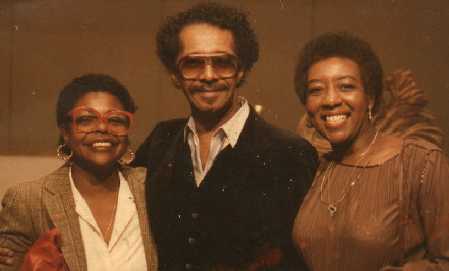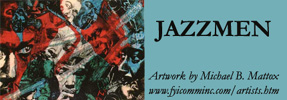JAZZ CITY: THE PHILADELPHIA JAZZ LEGACY
There are
four major components that gave Philadelphia Jazz its unique sound:
1.
The
influence of structured chord changes from the symphony;
2.
The
polyrhythmic improvisation interjected by the gospel influence;
3.
The 12 bar
syncopated refrain of the blues; and
4. The high level of technique introduced from the popular European marching band music, along with the 3/4 rhythm of the Waltz.
Thus,
Philadelphia's Sophisticated Jazz was born. Many musicians playing
this sound traveled the nation and the world performing and, in the wee
hours of the morning, they congregated in the Black clubs of America and
in European cafes and bistros, where they established the legacy of
Philadelphia as the Jazz City.
During the
Depression, many African-American families fled the rural South looking
for work. Their migration began in Georgia, gathering additional family
members, as they ascended through South Carolina, North Carolina and
Virginia. Noted Philadelphians who had the greatest impact on the jazz
scene of today, were either born in or had relatives from areas in the
Southern District. As they trekked North to New York, Philadelphia, a
thriving metropolis, became an attractive alternative. This city was an
economic stronghold with a multitude of jobs. Also, it was one of the most
populated cultural melting pots of the era. Blacks in Philadelphia held
better positions and were better educated than anywhere else in the United
States. Their lifestyle and earning potential paralleled White society of
the time. This was, in part, due to the longstanding moral influence of
the Quakers in this area, during the pre-Reconstruction era.
As Black
Americans traveled to Philadelphia, the Blues traveled with them. When
migrants arrived in Philly, they found many classically trained musicians,
who played symphonic music and the popular European music of the time. It
was this atypical blend of the European influence on the Blues, along with
Philadelphia's popular gospel sound, that created a unique form of Jazz
indigenous to Philly. Philadelphia Jazz was sophisticated. The
music reflected an extremely literate, very conservative Black middle and
upper class population. Since there were few commercial clubs for
African-Americans in the Philadelphia, in the 1920's and 1930's, the music
was played in the privately owned facilities of social and fraternal
organizations like the Elks and at cotillions of social clubs like Jack
& Jill.
New Orleans
is recognized as a regional center of Jazz and known to have fostered
Dixieland. Kansas City is identified as the birthplace of KC Blues, and
everyone is familiar with the Delta Blues of Mississippi. New York Jazz is
HIP, Chicago Jazz is RAW, but Philadelphia is the only place where Jazz is
sophisticated. Now is the time for Philadelphia to take its place
among the jazz centers of the world to rightfully be called Jazz
City.
Philadelphia's
jazz legacy includes jazz giants Dizzy Gillespie, Mickey Roker, Heath
Brothers, John Coltrane, Jimmy Oliver, C-Sharp, Cat Anderson, Lex
Humphrey, McCoy Tyner, Jimmy Garrison, Gerry Mulligan, Philly Joe Jones,
Grover Washington, Jr., Shirley Scott, Rufus Harley, Trudy Pitts, Mr. C,
Sun Ra, Odean Pope, Eddie Green, Christian McBride, Gerald Price, Joan
Cartwright, Byard Lancaster and Monnette Sudler. Too often, they are
thrown into a category that belies their endemic affiliation with this
City. There is little documentation to support the postulation of
Philadelphia's unique style of jazz; the tremendous influence of
Philadelphian's on the international jazz scene; or the impact individual
Philadelphia musicians have as innovators on the mindset of modern jazz
practitioners.
The Jazz City Film Series covers the Philadelphia jazz vista beginning with Bebop in the 1940's through the music of the present Young Lions. The breakdown of each component is as follows:
§
Part One:
Bebop - 1940's
§
Part Two:
Hard Bop - 1950's
§
Part Three:
Jazz Fusion - 1960's
§
Part Four:
Avant Garde - 1970/80's
§
Part Five:
The Ladies of Jazz - (1940-1990)
§
Part Six:
The Young Lions -1990's
Philadelphia
is on the verge of a cultural and economic renaissance. As we look to the
future of this great City, Jazz City: The Philadelphia Jazz Legacy
will place Philadelphia in its proper historical perspective as parent of sophisticated
jazz and rightful owner of the title JAZZ CITY.
Wayne
D. Nance
A graduate of Spring Garden
College, Wayne D. Nance has with a background in electronic technology.
Nance’s love affair with high-tech equipment went hand-in-hand with his
desire to do more than installation and repair.
At Temple University, Nance moved
to the next level, majoring in Radio, TV and Film Production. He developed
production and announcing skills at WRTI - FM 90.1, Temple's radio
station.
Wayne became an integral part of
this nationally known jazz station, while teaching video production, in
his spare moments. One thing led into another and, in 1979, Nance began
taping live jazz performances, turning them into half-hour cable ready
segments. The initial productions, entitled "JAZZ CITY",
aired on Cable TV in New York City, because cable TV was not available in
Philadelphia, at that time.
Now, a decade later, Nance's "JAZZ
CITY" can be seen on cable and broadcast TV in New York, New
Jersey, Philadelphia and surrounding counties in Pennsylvania.
Musicians included in the series
are:
§
Shirley Scott (Interview and Performance)
§
E. Diane Lyle Smith (Interview and Performance)
§
Monnette Sudler (Interview and Performance)
§
Carol Harris (Interview and Performance)
§
Jimmy Oliver (Interview and Performance)
§
Khan Jamal (Interview and Performance)
§
Trudy Pitts
§
Bernard Samuel
§
Evelyn Simms
§
Barbara Walker
Rufus Harley,
Jr. (b. near Raleigh,
North Carolina, May
20, 1936;
d. Philadelphia,
Pennsylvania, July
31, 2006)
was an American
jazz musician
of mixed Cherokee
and African ancestry, known primarily as the first jazz musician to adopt
the Scottish
great Highland bagpipe as his primary instrument.
Although born near Raleigh, North Carolina, at an early age Harley moved
with his mother to a poor neighborhood in North
Philadelphia, Pennsylvania. He began playing the C
melody saxophone at age 12, and also played trumpet. At the age of 22,
he began studying saxophone, flute, oboe, and clarinet with Dennis
Sandole (1913-2000), an Italian
American jazz
guitarist who also taught several other Philadelphia jazz musicians.[1]
Harley became inspired to learn the bagpipe after seeing the Black
Watch perform in John
F. Kennedy's funeral procession in November 1963.
Then a maintenance worker for the Philadelphia's housing authority, Harley
began searching the city for a set of bagpipes. Failing to find one, he
traveled to New
York City where he found a set in a Jewish-operated pawn shop. He
purchased the instrument for US$120, quickly adapting it to the idioms of
jazz, blues,
and funk.[2]
On several occasions, when a neighbor called the police to complain about
Harley's practicing in his apartment, he would quickly put away his
bagpipes and feign ignorance, asking the officers, "Do I look like
I'm Irish or Scottish to you?"[3]
He eventually acquired a better set of bagpipes, which cost him a little
over US$1,000.[4]
Harley made his bagpipe performance debut in 1964. From 1965 to 1970 he
released four recordings as leader on the Atlantic
label (all produced by Joel
Dorn, an early supporter), also recording as a sideman with Herbie
Mann, Sonny
Stitt, and Sonny
Rollins in the 1960s and 1970s. He later recorded with Laurie
Anderson (appearing on her 1982 album Big
Science) and The
Roots (on their 1995 album Do
You Want More?!!!??!), the latter coming about due to a 1994
appearance on The
Arsenio Hall Show. In addition to bagpipes, on these albums he
also occasionally plays tenor
saxophone, flute, or electric soprano
saxophone.
Harley often wore Scottish garb, including a kilt,
in conjunction with a Viking-style
horned
helmet. After seeing him perform on television, a Scottish family gave
him his tartan,
the McLeod tartan, which he wore for the rest of his life.[5]
His bagpipe technique was somewhat unorthodox in that he placed the drones
over his right shoulder rather than his left. He favored the key of B-flat
minor.
Harley lived for much of his life in the Germantown
neighborhood of Northwest
Philadelphia,
Pennsylvania, and frequently gave presentations in Philadelphia-area
public schools. During his frequent overseas performance tours, he carried
and distributed miniature replicas of the Liberty
Bell, the symbol of his hometown, as well as American flags and copies
of the U.S.
Constitution. He appeared on a number of television programs,
including What's
My Line?, To
Tell the Truth (March 22, 1965 [6]
and again c. 2000), I've
Got a Secret (October 17, 1966),[7]
and The Arsenio Hall Show. He also had a small role in Francis
Ford Coppola's 1966 comedy film You're
a Big Boy Now. In addition to his performing career, he worked for
the Philadelphia Housing Authority for many years.
He died at Philadelphia's Albert Einstein Medical Center on July
31, 2006
of prostate
cancer.[8]
He is survived by his former wife Barbara Jean Jones, 16 children and 15
grandchildren. One of his sons, Messiah Patton Harley, also of
Philadelphia, is a trumpeter who often performed with his father.

Carolyn McClendon, Philly
Joe Jones and Trudy Pitts

